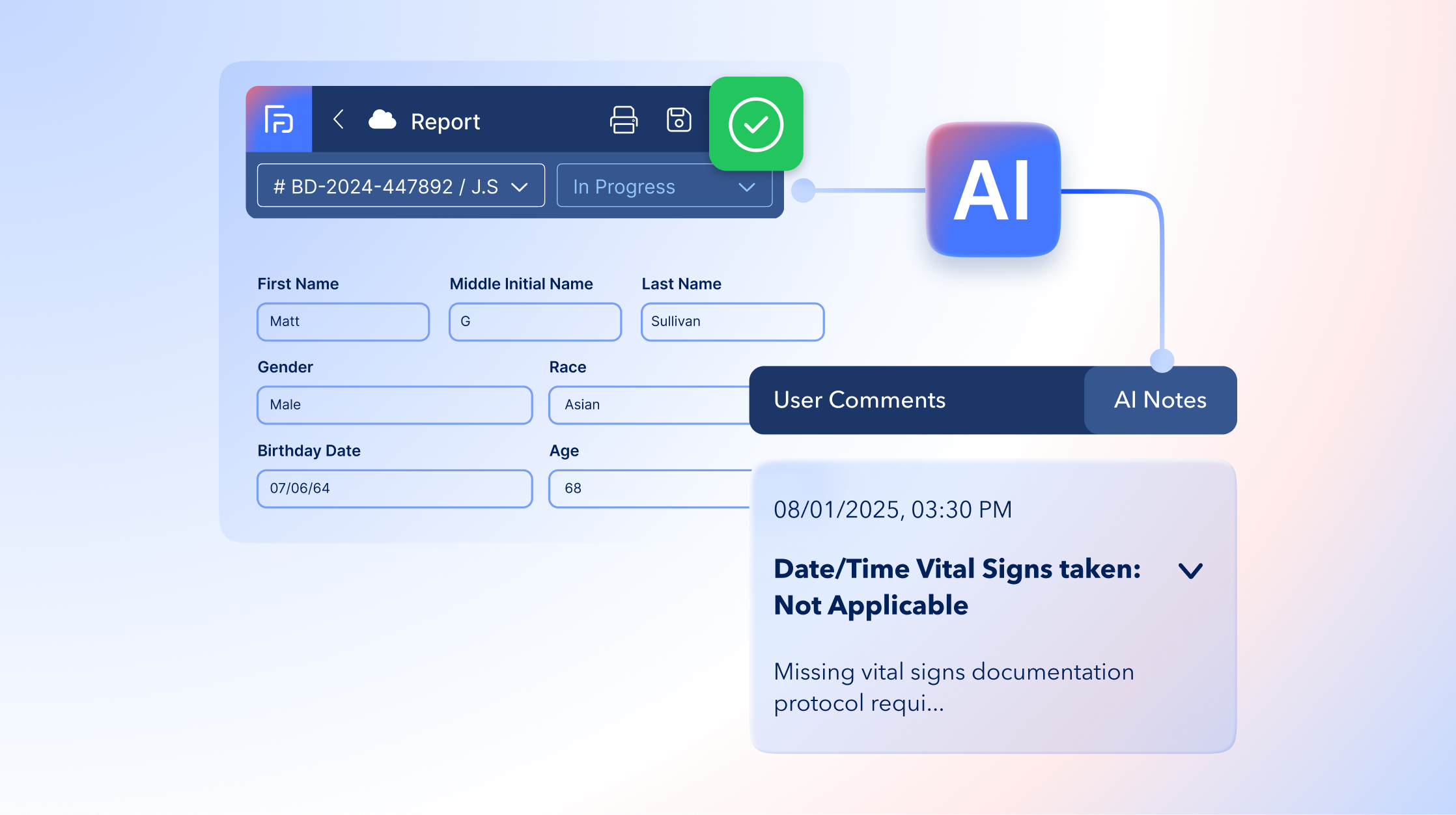From Burden to Breakthrough: How AI Is Changing EMS Documentation and QA/QI

The Challenge of EMS Documentation
For EMS professionals, providing high-quality care in unpredictable and high-pressure environments is always the top priority. Alongside patient care comes the responsibility of documenting every detail of an incident in compliance with state requirements, NEMSIS standards, and insurance guidelines. Manual documentation is time-consuming, often inconsistent, and frequently delayed until after a call is complete. This creates a cycle of incomplete records, potential compliance risks, and added stress for crews already working demanding shifts.
In an industry where every second counts, documentation should enhance care rather than slow it down. That is where AI-powered solutions are changing the landscape.
AI-Powered Documentation with ePCR
Electronic patient care reporting (ePCR) has long been essential to EMS operations, but AI-driven tools represent a major step forward. Instead of typing into a form while managing a patient, crews can now use natural speech to capture details in real time. The AI engine recognizes medical terms and patient information and automatically populates fields within the ePCR.
The impact is immediate:
- Crews spend less time typing and more time focusing on patient care.
- Reports are more complete, as natural conversations capture details that might otherwise be missed.
- Errors such as miscoding or typos are reduced, resulting in cleaner, more reliable data.
This innovation goes far beyond simple transcription. Unlike traditional voice-to-text tools, AI-powered ePCR completes structured data fields, ensuring every report meets compliance standards while reducing administrative workload. A built-in human review step allows crews to validate and finalize their reports before submission, maintaining accountability while improving efficiency.
AI in QA/QI: From Random Sampling to Full Coverage
Quality assurance and quality improvement (QA/QI) are vital for consistent, high-quality EMS care. Historically, agencies relied on random sampling of ePCRs, often reviewing only a few reports out of thousands. While manageable, this approach left blind spots and risked missing systemic issues.
AI has changed the model entirely. Every ePCR can now be automatically reviewed against agency protocols. Instead of searching manually for inconsistencies, medical directors receive only the reports that need attention.
This approach provides:
- Oversight of 100 percent of incidents rather than a limited sample.
- Significant time savings for medical directors and administrators.
- Faster identification of training needs and performance trends.
- Cleaner data for billing, compliance, and reporting.
With AI, agencies can now achieve complete visibility and a higher standard of accountability without adding to anyone’s workload.
The Value of an All-in-One Platform
The power of AI becomes even more meaningful when documentation and QA/QI are part of an all-in-one platform. Instead of siloed systems that duplicate effort, an integrated environment ensures insights from documentation flow directly into billing, scheduling, and operations.
Agencies benefit from:
- Seamless compliance with state and NEMSIS reporting requirements.
- Faster processing for insurance claims and reimbursements.
- Shared data across modules, reducing redundancy and increasing accuracy.
- Centralized visibility into every aspect of EMS operations.
Whether operating as a private ambulance service, hospital-based unit, municipal department, or county-wide agency, the ability to consolidate tools in one system creates efficiencies that impact every level of daily operations.
Real-World Impact: Time Saved, Outcomes Improved
AI-powered documentation and QA/QI are already delivering measurable results. Crews no longer spend hours after shifts trying to recall details from earlier calls. Instead, they complete accurate reports on scene or en route, reducing fatigue and freeing time for recovery.
Administrators and medical directors gain confidence in their data, knowing that every report has been automatically reviewed for accuracy and compliance. This leads to stronger documentation, better billing outcomes, and ultimately improved patient care.
What’s Next for AI in EMS
The innovations transforming EMS documentation today are only the beginning. Over the next few years, AI is expected to integrate with wearable devices, body cameras, and telehealth platforms to enable real-time collaboration between field providers and physicians. These advances will allow hospitals and specialists to access patient data and assist during incidents, improving both speed and quality of care.
Beyond individual responses, AI will support public health by detecting trends across jurisdictions. From early identification of disease outbreaks to monitoring trauma patterns, AI-enhanced EMS data will play an essential role in community health management.
Redefining the Future of EMS
EMS agencies face growing demands for accuracy, compliance, and efficiency in documentation and oversight. By using AI within ePCR and QA/QI processes, agencies can reduce administrative burdens, improve data quality, and uncover insights that drive better patient outcomes. When combined in an all-in-one platform, these tools not only save time but also create a foundation for the future of EMS.
AI is no longer an abstract concept for EMS. It is a practical, proven tool already reshaping how providers work, how agencies manage operations, and how communities receive care.
The Challenge of EMS Documentation
For EMS professionals, providing high-quality care in unpredictable and high-pressure environments is always the top priority. Alongside patient care comes the responsibility of documenting every detail of an incident in compliance with state requirements, NEMSIS standards, and insurance guidelines. Manual documentation is time-consuming, often inconsistent, and frequently delayed until after a call is complete. This creates a cycle of incomplete records, potential compliance risks, and added stress for crews already working demanding shifts.
In an industry where every second counts, documentation should enhance care rather than slow it down. That is where AI-powered solutions are changing the landscape.
AI-Powered Documentation with ePCR
Electronic patient care reporting (ePCR) has long been essential to EMS operations, but AI-driven tools represent a major step forward. Instead of typing into a form while managing a patient, crews can now use natural speech to capture details in real time. The AI engine recognizes medical terms and patient information and automatically populates fields within the ePCR.
The impact is immediate:
- Crews spend less time typing and more time focusing on patient care.
- Reports are more complete, as natural conversations capture details that might otherwise be missed.
- Errors such as miscoding or typos are reduced, resulting in cleaner, more reliable data.
This innovation goes far beyond simple transcription. Unlike traditional voice-to-text tools, AI-powered ePCR completes structured data fields, ensuring every report meets compliance standards while reducing administrative workload. A built-in human review step allows crews to validate and finalize their reports before submission, maintaining accountability while improving efficiency.
AI in QA/QI: From Random Sampling to Full Coverage
Quality assurance and quality improvement (QA/QI) are vital for consistent, high-quality EMS care. Historically, agencies relied on random sampling of ePCRs, often reviewing only a few reports out of thousands. While manageable, this approach left blind spots and risked missing systemic issues.
AI has changed the model entirely. Every ePCR can now be automatically reviewed against agency protocols. Instead of searching manually for inconsistencies, medical directors receive only the reports that need attention.
This approach provides:
- Oversight of 100 percent of incidents rather than a limited sample.
- Significant time savings for medical directors and administrators.
- Faster identification of training needs and performance trends.
- Cleaner data for billing, compliance, and reporting.
With AI, agencies can now achieve complete visibility and a higher standard of accountability without adding to anyone’s workload.
The Value of an All-in-One Platform
The power of AI becomes even more meaningful when documentation and QA/QI are part of an all-in-one platform. Instead of siloed systems that duplicate effort, an integrated environment ensures insights from documentation flow directly into billing, scheduling, and operations.
Agencies benefit from:
- Seamless compliance with state and NEMSIS reporting requirements.
- Faster processing for insurance claims and reimbursements.
- Shared data across modules, reducing redundancy and increasing accuracy.
- Centralized visibility into every aspect of EMS operations.
Whether operating as a private ambulance service, hospital-based unit, municipal department, or county-wide agency, the ability to consolidate tools in one system creates efficiencies that impact every level of daily operations.
Real-World Impact: Time Saved, Outcomes Improved
AI-powered documentation and QA/QI are already delivering measurable results. Crews no longer spend hours after shifts trying to recall details from earlier calls. Instead, they complete accurate reports on scene or en route, reducing fatigue and freeing time for recovery.
Administrators and medical directors gain confidence in their data, knowing that every report has been automatically reviewed for accuracy and compliance. This leads to stronger documentation, better billing outcomes, and ultimately improved patient care.
What’s Next for AI in EMS
The innovations transforming EMS documentation today are only the beginning. Over the next few years, AI is expected to integrate with wearable devices, body cameras, and telehealth platforms to enable real-time collaboration between field providers and physicians. These advances will allow hospitals and specialists to access patient data and assist during incidents, improving both speed and quality of care.
Beyond individual responses, AI will support public health by detecting trends across jurisdictions. From early identification of disease outbreaks to monitoring trauma patterns, AI-enhanced EMS data will play an essential role in community health management.
Redefining the Future of EMS
EMS agencies face growing demands for accuracy, compliance, and efficiency in documentation and oversight. By using AI within ePCR and QA/QI processes, agencies can reduce administrative burdens, improve data quality, and uncover insights that drive better patient outcomes. When combined in an all-in-one platform, these tools not only save time but also create a foundation for the future of EMS.
AI is no longer an abstract concept for EMS. It is a practical, proven tool already reshaping how providers work, how agencies manage operations, and how communities receive care.







.png)